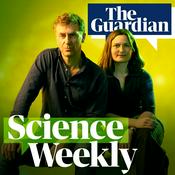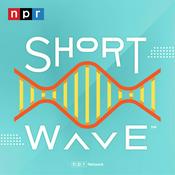657 episódios

Beyond the Periodic Table
29/12/2025 | 56min
You interact with about two-thirds of the elements of the periodic table every day. Some, like carbon, oxygen, and nitrogen, make up our bodies and the air we breathe. Yet there is also a class of elements so unstable they can only be made in a lab. These superheavy elements are the purview of a small group stretching the boundaries of chemistry. Can they extend the periodic table beyond the 118 in it now? Find out scientists are using particle accelerators to create element 120 and why they’ve skipped over element 119. Plus, if an element exists for only a fraction of a second in the lab, can we still say that counts as existing? Guests: Mark Miodownik – professor of materials and society at the University of College London and the author of “It’s a Gas: The Sublime and Elusive Elements That Expand Our World.” Kit Chapman – Science historian at Falmouth University, author of “Superheavy; Making and Breaking the Periodic Table.” Jennifer Pore – Research Scientist of Heavy Elements at Lawrence Berkeley National Laboratory. Featuring music by Dewey Dellay and Jun Miyake Big Picture Science is part of the Airwave Media podcast network. Please contact [email protected] to inquire about advertising on Big Picture Science. You can get early access to ad-free versions of every episode by joining us on Patreon. Thanks for your support! Learn more about your ad choices. Visit megaphone.fm/adchoices

Movie Mayhem
22/12/2025 | 56min
Science fiction movies force us to face a multitude of end-of-the-world scenarios. Whether the final curtain is dropped by rampaging aliens, killer rocks from space, or virus-infected zombies, these big screen glimpses of a dystopian future are as tantalizing as they are frightening. But one American city seems to be a favorite backdrop for stories of mass destruction. We speak with a cultural critic about why New York City is often the chosen setting for disaster films, and what dystopian fiction reveals about our shifting anxieties about humanity’s future no matter where we live. Movies discussed include Deep Impact, Escape from New York, Planet of the Apes, King Kong, Cloverfield, Deluge, Failsafe, The Day After Tomorrow, AI: Artificial Intelligence, Contagion, I Am Legend, and Seth’s very own short film: The Turkey that Ate St. Louis Guest: Dan Saltzstein – Deputy Editor for Projects and Collaborations, New York Times Featuring music by Dewey Dellay and Jun Miyake Big Picture Science is part of the Airwave Media podcast network. Please contact [email protected] to inquire about advertising on Big Picture Science. You can get early access to ad-free versions of every episode by joining us on Patreon. Thanks for your support! Learn more about your ad choices. Visit megaphone.fm/adchoices

The Best Things in Life are Tree(s)
15/12/2025 | 58min
While humans were leaving the Stone Age and entering the Bronze, some Bristlecone pine trees grew from seeds to sprouts. They’ve been growing ever since. These 5,000-year-old pines are among the oldest organisms on Earth. Superlatives are also appropriate for the towering redwoods. Trees are amazing in many ways. They provide us with timber and cool us with shade, they sequester carbon and release oxygen, and are home to countless species. But they are also marvels of evolutionary adaptation. We consider the beauty and diversity of trees, and learn why their future is intertwined with ours. Guests: Kevin Dixon - Naturalist at The East Bay Regional Park District, Oakland, California Daniel Lewis - Environmental historian and senior curator for the History of Science and Technology at the Huntington Library, art museum and botanical gardens in Pasadena, California, professor of the natural sciences and the environment at Caltech, and author of “Twelve Trees: The Deep Roots of our Future” Featuring music by Dewey Dellay and Jun Miyake Originally aired January 25, 2025 Big Picture Science is part of the Airwave Media podcast network. Please contact [email protected] to inquire about advertising on Big Picture Science. You can get early access to ad-free versions of every episode by joining us on Patreon. Thanks for your support! Learn more about your ad choices. Visit megaphone.fm/adchoices

A Real Gas
08/12/2025 | 57min
Just because something is invisible doesn’t mean it isn’t there. We can’t see gases in our atmosphere, such as carbon dioxide, oxygen, and nitrogen, but we benefit from their presence with every breath we take. From the bubbles that effervesce in soda to the vapors that turn engines, gases are part of our lives. They fill our lungs, give birth to stars, and… well, how would we spot a good diner without glowing neon? In this episode, a materials scientist shares the history of some gaseous substances that we don’t usually see, but that make up our world. Guest: Mark Miodownik – Professor of materials and society at the University College London and the author of “It’s a Gas: The Sublime and Elusive Elements That Expand Our World.” Featuring music by Dewey Dellay and Jun Miyake Originally aired December 9, 2024 Big Picture Science is part of the Airwave Media podcast network. Please contact [email protected] to inquire about advertising on Big Picture Science. You can get early access to ad-free versions of every episode by joining us on Patreon. Thanks for your support! Learn more about your ad choices. Visit megaphone.fm/adchoices

Amazing Amazonia
01/12/2025 | 1h 13min
The Amazon is often described as an ecosystem under dire threat due to climate change and deliberate deforestation. Yet there is still considerable hope that these threats can be mitigated. In the face of these threats, indigenous conservationists are attempting to strike a balance between tradition and preserving Amazonia. Meanwhile, two river journeys more than 100 years apart – one by a contemporary National Geographic reporter and another by “The Lewis and Clark of Brazil”— draw attention to the beauty and diversity of one of the world’s most important ecosystems. Guests: Cynthia Gorney – Contributing writer at the National Geographic Society, former bureau chief for South America at The Washington Post Larry Rohter – Reporter and correspondent in Rio de Janeiro for fourteen years for Newsweek and as The New York Times bureau chief. Author of Into the Amazon: The Life of Cândido Rondon, Trailblazing Explorer, Scientist, Statesman, and Conservationist João Campos-Silva – Brazilian researcher and conservationist, and cofounder of Instituto Jura, a conservation organization. His work, along with that of other conservationists, is featured in the National Geographic issue devoted to the Amazon. Featuring music by Dewey Dellay and Jun Miyake Big Picture Science is part of the Airwave Media podcast network. Please contact [email protected] to inquire about advertising on Big Picture Science. You can get early access to ad-free versions of every episode by joining us on Patreon. Thanks for your support! Learn more about your ad choices. Visit megaphone.fm/adchoices
Mais podcasts de Ciência
Podcasts em tendência em Ciência
Sobre Big Picture Science
Ouça Big Picture Science, Astronomia em Meia Hora e muitos outros podcasts de todo o mundo com o aplicativo o radio.net

Obtenha o aplicativo gratuito radio.net
- Guardar rádios e podcasts favoritos
- Transmissão via Wi-Fi ou Bluetooth
- Carplay & Android Audo compatìvel
- E ainda mais funções
Obtenha o aplicativo gratuito radio.net
- Guardar rádios e podcasts favoritos
- Transmissão via Wi-Fi ou Bluetooth
- Carplay & Android Audo compatìvel
- E ainda mais funções


Big Picture Science
baixe o aplicativo,
ouça.





































